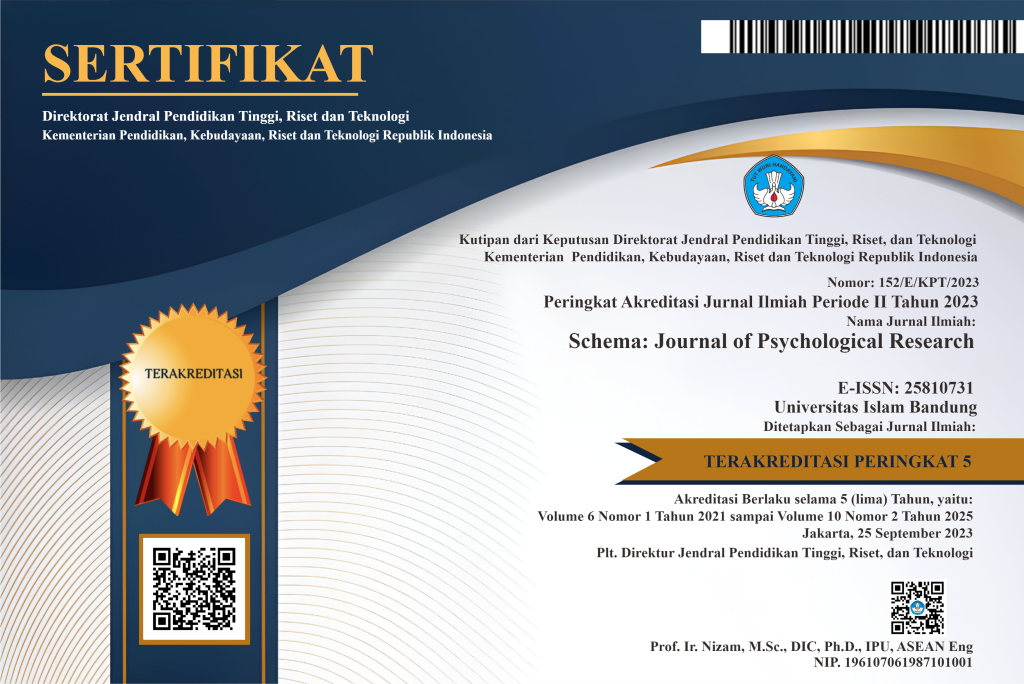Peran Kelekatan dengan Teman Sebaya pada Otonomi di Mahasiswa
Abstract
Keywords
Full Text:
PDFReferences
Armsden, G. C.,& Greenberg, M. T. (1987). The inventory of parent and peer attachment: individual differences and their relationship to psychological well-being in adolescence. Journal of Youth and Adolescence, 427-454
Arnett, J. J. (2007). Emerging adulthood: What is it, and what is it good for?. Child development perspectives, 1(2), 68-73
Barrocas, A.L. (2009). Adolescent attachment to parents and peers. [Online]. Diambil dari http://ejournal.narotama.ac.id/files/barrocas%20thesisfinal.pdf
Bowlby, J. (1988). A secure base: Parent-child attachment and healthy human development. Basic Books.
Bülow, A., Keijsers, L., Boele, S., van Roekel, E., & Denissen, J. J. A. (2020). Parenting Adolescents in Times of a Pandemic: Changes in Relationship Quality, Autonomy Support, and Parental Control? doi:10.31234/osf.io/g8kpf
Creswell, J. W. (2014). Research design: Qualitative, quantitative, and mixed methods approaches 4th edition. SAGE.
Dewi, A. A., & Valentina, T. D. (2013). Hubungan kelekatan orang tua-remaja dengan kemandirian pada remaja di SMKN 1 Denpasar. Jurnal Psikologi Udayana, 181-189
Fioretti, C., Palladino, B. E., Nocentini, A., & Menesini, E. (2020). Positive and Negative Experiences of Living in COVID-19 Pandemic: Analysis of Italian Adolescents’ Narratives. Frontiers in Psychology, 11. doi:10.3389/fpsyg.2020.599531
Ghozali, I. (2018). Aplikasi analisis multivariete dengan program IBM SPSS 23. Semarang: Badan Penerbit Universitas Diponegoro.
Hurst, J. R. (2010). The development of adolescent autonomy: contribustions of the mother-child attachment relationship and maternal sensitivity. The university of Texas at Dallas, 1-65
Keizer, R., Helmerhorst, K. O. W., & Gelderen, L. R. (2019). Perceived quality of the mother-adolescent and father adolescent attachment relationship and adolescents’ self-esteem. Journal of Youth and Adolescence, 48(6), 1203-1217. https://doi.org/10.1007/s10964-019-01007-0
Leedy, P, D., & Ormrod, J, E., (2015). Practical Research: Planning And Design 11th Edition. New York: Pearson
Lemme, B. H. (1999). Development in adulthood (2nd ed.). McGraw-Hill.
Martono, N. (2014). Metode penelitian kuantitatif: Analisis isi dan analisis data sekunder edisi revisi ke-2. Jakarta: PT Raja Grafindo Persada
Murphy, D. A., Greenwell, L., Resell, J., Brecht, M.-L., & Schuster, M. A. (2008). Early and middle adolescent's autonomy development. Clinical child psychology psychiatry, 253-276
Nalipay, M. J. N., King, R. B., & Cai, Y. (2020). Autonomy is equally important across East and West: Testing the cross-cultural universality of self-determination theory. Journal of Adolescence, 78, 67–72. doi:10.1016/j.adolescence.2019.12
Noom, M. J., Dekovic, M., & Meeus, W. (1999). Autonomy, attachment and psychosocial adjustment during adolescence: a double-edged sword?. Journal of youth and adolescence, 22, 771-783.
Noom, M. J., Dekovic, M., & Meeus, W. (2001). Conceptual analysis and measurement of
adolescent autonomy. Journal of youth and adolescence, 577-595.
Nuryadi., Astuti, T. D., Utami, E. S., & Budiantara, M. (2017). Dasar-dasar statistik penelitian. Sibuku Media.
Nursalikah, A. (2018, November 12). Jumlah mahasiswa Indonesia masih sedikit. republika.co.id. https://republika.co.id/berita/pi2o7r366/jumlah-mahasiswa-indonesia-masih-sedikit.
Permatasari, N. I., & Kurniawan, I. N. (2002). Hubungan antara kelekatan terhadap orang tua dengan otonomi pada remaja. Jurnal psikologi UII, 1-12.
Prabowo, R. D., & Aswanti, M. (2014). Hubungan attachment ibu-anak dan ayah-anak dengan kemandirian pada remaja akhir. Jurnal psikologi UI, 1-16.
Reifman, A., Arnett, J.J., & Colwell, M.J. (2007). Emerging adulthood: Theory, assessment and application. Journal of Youth Development, 2(1), 37-48, https://doi.org/10.5195/jyd.2007.359
Santrock. J.W. 2019. Life-span development 17th edition. New York: McGraw Hill.
Schwartz, B. (2000). Self-determination: The tyranny of freedom. American Psychologist, 55, 79–88
Siregar, S. (2013). Metode penelitian kuantitatif: Dilengkapi dengan perbandingan perhitungan manual & SPSS edisi pertama. Kencana Prenadamedia Group.
Sudarmanto, R. G. (2005). Analisis regresi linear ganda dengan SPSS. Yogyakarta: Graha Ilmu.
Sugiyono. (2013). Metode penelitian kuantitatif, kualitatif, dan R&D. Jakarta: Alfabeta.
Supratiknya, A. (2015). Metodologi penelitian kuantitatif & kualitatif dalam psikologi. Universitas Sanata Dharma.
Suryabarata, S. (2006). Metodologi penelitian. Raja Grafindo Persada.
Steinberg.L. 2002. Adolescence 6 edition. Boston: Mc graw hill.
Therriault, D., Lemenlin, J.P., Toupin, J., & Dery, M. (2021). Factor associated with parent-adolescent attachment relationship quality: a longitudinal study. Adolescent, 1(2), 159-174, https://doi.org/10.3390/adolescents102001
Wilkinson, R. B. (2004). The Role of Parental and Peer Attachment in the Psychological Health and Self-Esteem of Adolescents. Journal of Youth and Adolescence, 33 (4)
Yusuf, A. M. (2014). Metode penelitian: Kuantitatif, kualitatif, dan penelitian gabungan. Jakarta: Kencana.
Zimmer-Gembeck, M.J., & Collins, W.A. (2003). Autonomy development during adolescence.
In G.R. Adams & M. Berzonsky (Eds.), Blackwell Handbook of adolescence (pp. 175-204). Oxford: Blackwell Publishers.
DOI: https://doi.org/10.29313/schema.v8i1.11657
Refbacks
- There are currently no refbacks.
Indexed by:
This work is licensed under a Creative Commons Attribution-NonCommercial-ShareAlike 4.0 International License.












